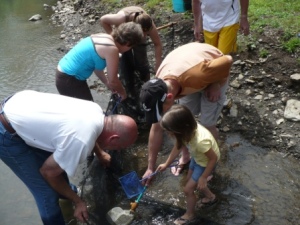The best way to learn is to get your feet wet, or at least that is how I feel when I give this program. These park guests are taking part in my creek seining program. It was developed to help monitor the aquatic life found in Lee Creek, but it turned into so much more. As they were scooping up fish this little girl got her first look at a dragonfly larvae, she had no idea that these winged insects start their lives in the water. As we moved farther down the creek they continued to collect all sorts of things; minnows, darters, crayfish, dragonfly larvae, tadpoles, and even a snake. They couldn’t believe the amount of life that lives in this small creek. It was a great experience for all them to understand that this creek plays so many roles in the park, including home to many creatures.
This is why I enjoy resource management programs in the park. It gives everyone an opportunity to go behind the scenes, and become a citizen scientist. They get to see things differently, they get to hold the resources in their hand and get a better understanding of the park itself. This also helps us accomplish part of our mission “To safeguard the natural, historical and cultural resources.” To do this we keep a natural resource inventory in the park to monitor these resources. This can be a pretty daunting task, so having help is a great benefit.
Another program that involves collecting data is our bird hike. It is so much more enjoyable to see birds through binoculars than squinting to make out its colors and features. It is also fun to just sit back and listen, but regardless of how we are identifying them we are adding to our inventory so that we can continue to protect and admire these creatures. This monitoring was very important last year in the addition of Spotted Towhee, Lark Sparrow, and Clay-colored Sparrow to our park list.
I also like to present programs that give an opportunity to explore and observe on your own, such as a reptile and amphibian program that showcase some of our native animals. This gives everyone the tools to identify what they find so they can report it back to us at the park. By gathering observations we can have eyes all over the park and cover more ground.
There are many opportunities to become a citizen scientist no matter where you live or what park you visit, so we encourage you to get out and start exploring. Help us by telling what plants you found or what animals you saw. By helping us you can be sure that our great parks will be around forever.
Adam Leslie is a Park Interpreter at Devil’s Den State Park. He has been there since September of 2009. Prior to Devil’s Den he was a seasonal interpreter at Petit Jean State Park. He received a degree in Wildlife Management and Ecology from Arkansas State State. His main interest is natural resource management.






 Posted by Arkansas State Parks
Posted by Arkansas State Parks 


 Facebook
Facebook Twitter
Twitter YouTube
YouTube
